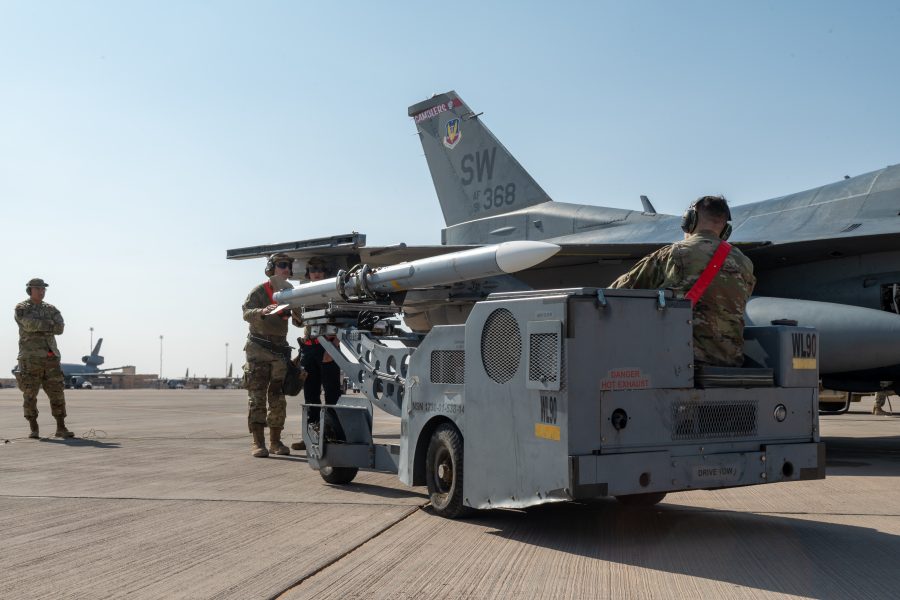Rep. Mike Rogers (R-Ala.), chairman of the House Armed Services Committee, wants to make sure the Air Force and Navy have enough air-to-air missiles for their crewed and uncrewed fighters through the end of the decade and is directing them to submit an annual assessment of the threat and need in his markup of the 2025 National Defense Authorization Act.
Specifically, Rogers wants to know if the services require more AIM-120 Advanced Medium Range Air-to-Air Missiles than they’re planning to buy, and whether an extended-range version should be added to the acquisition plan. Such a weapon could be a “hedge” against failure or delay of other air-to-air missiles in development, he said, such as the AIM-260 Joint Advanced Tactical Missile (JATM).
A provision in the bill would require the Air Force and Navy to submit a report to Congress, coordinated with the regional commanders-in-chief, by April 2025 on “the sufficiency of established inventory requirements” for AMRAAM through fiscal 2029, followed by annual updates. The House Armed Services Committee will mark up the bill May 22, and it must then pass the full House and reconciled with the Senate version.
The services’ report would explain the numbers and types of air-to-air missiles the services are developing, how many they expect to put in service, as well as the planned inventories of each type, by year.
The Pentagon is known to be developing a number of new air-to-air missiles—and evaluating several developed independently by contractors—with the intent of obtaining longer-range weapons to shoot from a greater distance, while achieving a smaller missile size to increase the number of shots available to each individual flying platform.
Pentagon acquisition and sustainment chief William LaPlante and Joint Chiefs of Staff Chairman Gen. Charles Q. Brown Jr., have both said recently that munitions tend to be “the bill-payers” in budget crunches, and both noted a boost in the multiyear buy of AMRAAM in the fiscal 2025 budget request to address this tendency.
Through 2029—the apparent end of AMRAAM procurement—the Pentagon plans to buy:
- 457 missiles in 2024
- 462 in 2025
- 664 in 2026
- 118 in 2027
- 9 in 2028
- Zero in 2029
Rogers wants the Air Force/Navy report coordinated with regional COCOMs, who would be directed to state the missile levels needed “to support the operational plans of the United States Central Command, the United States Indo-Pacific Command, the United States Northern Command, and the United States European Command, assessed separately for each command at low-, medium-, and high-risk levels.”
The annual report is also to look at “emerging requirements for surface-to-air defense and collaborative combat aircraft capabilities, and how such emerging requirements are expected to impact inventory requirements for air-to-air missiles.”
The AMRAAM is used in the National Advanced Surface-to-Air Missile System (NASAMS), which is being provided to Ukraine. The system launches the AMRAAM from the ground against air threats.
It is also presumed that AMRAAMs will be carried by Collaborative Combat Aircraft (CCAs) the Air Force and Navy are planning to use for air-to-air combat.
The Air Force is working on the AIM-260 JATM, which is to improve on AMRAAM’s range by several times, to achieve parity or dominance over China’s advanced, long-range PL-15. However, the Air Force has said nothing recently about progress in fielding JATM, which was originally planned to be operational in 2022.
A problem with fielding the JATM might explain Rogers’ interest in pursuing an extended-range AMRAAM as a stopgap. The Air Force consistently declines to discuss the JATM or its progress.
The Navy is also working on a successor to the AIM-9X Sidewinder. The radar-guided AMRAAM is meant to defeat targets beyond visual range while the infrared-guided Sidewinder has traditionally been meant for targets within visual range. With the advent of stealth aircraft in competitor air forces, though, the Navy has been developing IR missiles with longer range, and the Air Force wants a radar missile that can find stealthy targets farther away.
The report Rogers wants would include “whether extending the AIM-120 Advanced Medium-Range Air-to-Air Missile program of record through 2029 would enhance available inventories of air-to-air missiles during such period” and if the acquisition plan should “include development and fielding of an AIM-120D Extended Range missile.” Rogers wants to know what number of AMRAAMs are needed to meet COCOM needs “at a medium-level of operational risk.”
The Air Force in particular is to report on whether AMRAAM could be extended by assessing “how new propellants, binding agents, and other enhancements may increase the capabilities of such a missile” and whether buying such a weapon “could hedge against current or future air-to-air missile inventory, capacity, capability or shortfall risks.”
Either way, Rogers wants the Air Force to “develop a budget profile and schedule that would support expedited fielding of such a missile.”
The Secretaries of the Air Force and Navy are to submit the requirements report, while the Air Force Secretary is to submit the report on extending the AMRAAM. RTX’s Raytheon builds AMRAAM, and a company spokesperson said the company would not comment on the chairman’s mark.
